Financial Statement Analysis Report of British Land - AC4410
VerifiedAdded on 2023/06/15
|11
|1849
|423
Report
AI Summary
This report presents a financial analysis of British Land, a leading UK commercial property company, utilizing ratio analysis to assess its performance. The analysis covers profitability ratios (gross profit margin, operating profit margin, return on capital employed), liquidity ratios (current ratio, quick ratio), and gearing ratios (gearing ratio, interest coverage ratio) for the years 2014-2017. The report concludes that British Land is in a stable position regarding profitability, liquidity, and solvency, but suggests improvements such as managing short-term liabilities and favoring equity over debt financing for future funding. The analysis is based on the company's financial statements and aims to provide insights into its financial health and potential areas for improvement.

Running head: ACCOUNTING FINANCIAL ANALYSIS REPORT
Accounting financial analysis report
Name of the student
Name of the university
Student ID
Author note
Accounting financial analysis report
Name of the student
Name of the university
Student ID
Author note
Paraphrase This Document
Need a fresh take? Get an instant paraphrase of this document with our AI Paraphraser
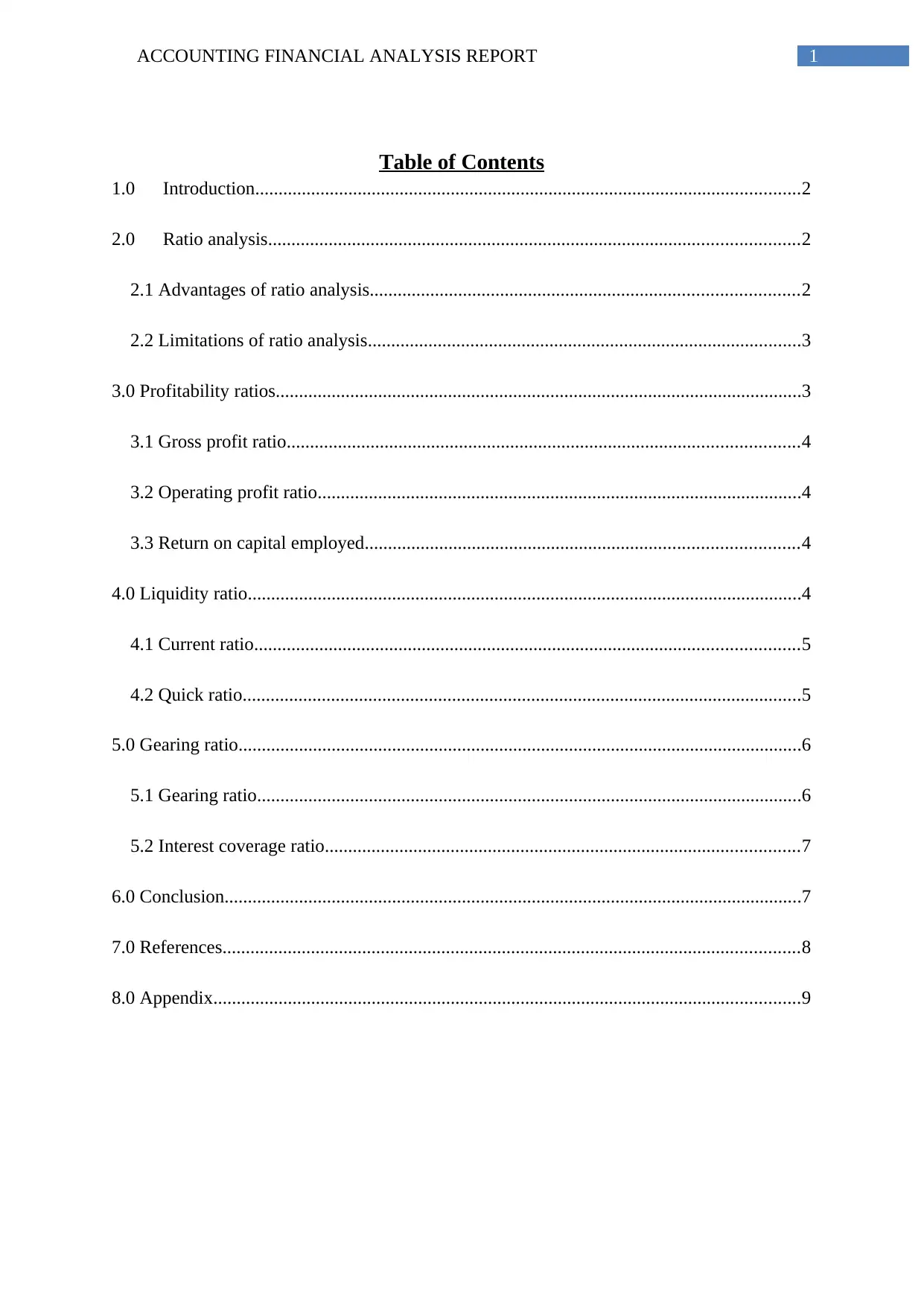
1ACCOUNTING FINANCIAL ANALYSIS REPORT
Table of Contents
1.0 Introduction.....................................................................................................................2
2.0 Ratio analysis..................................................................................................................2
2.1 Advantages of ratio analysis............................................................................................2
2.2 Limitations of ratio analysis.............................................................................................3
3.0 Profitability ratios.................................................................................................................3
3.1 Gross profit ratio..............................................................................................................4
3.2 Operating profit ratio........................................................................................................4
3.3 Return on capital employed.............................................................................................4
4.0 Liquidity ratio.......................................................................................................................4
4.1 Current ratio.....................................................................................................................5
4.2 Quick ratio........................................................................................................................5
5.0 Gearing ratio.........................................................................................................................6
5.1 Gearing ratio.....................................................................................................................6
5.2 Interest coverage ratio......................................................................................................7
6.0 Conclusion............................................................................................................................7
7.0 References............................................................................................................................8
8.0 Appendix..............................................................................................................................9
Table of Contents
1.0 Introduction.....................................................................................................................2
2.0 Ratio analysis..................................................................................................................2
2.1 Advantages of ratio analysis............................................................................................2
2.2 Limitations of ratio analysis.............................................................................................3
3.0 Profitability ratios.................................................................................................................3
3.1 Gross profit ratio..............................................................................................................4
3.2 Operating profit ratio........................................................................................................4
3.3 Return on capital employed.............................................................................................4
4.0 Liquidity ratio.......................................................................................................................4
4.1 Current ratio.....................................................................................................................5
4.2 Quick ratio........................................................................................................................5
5.0 Gearing ratio.........................................................................................................................6
5.1 Gearing ratio.....................................................................................................................6
5.2 Interest coverage ratio......................................................................................................7
6.0 Conclusion............................................................................................................................7
7.0 References............................................................................................................................8
8.0 Appendix..............................................................................................................................9
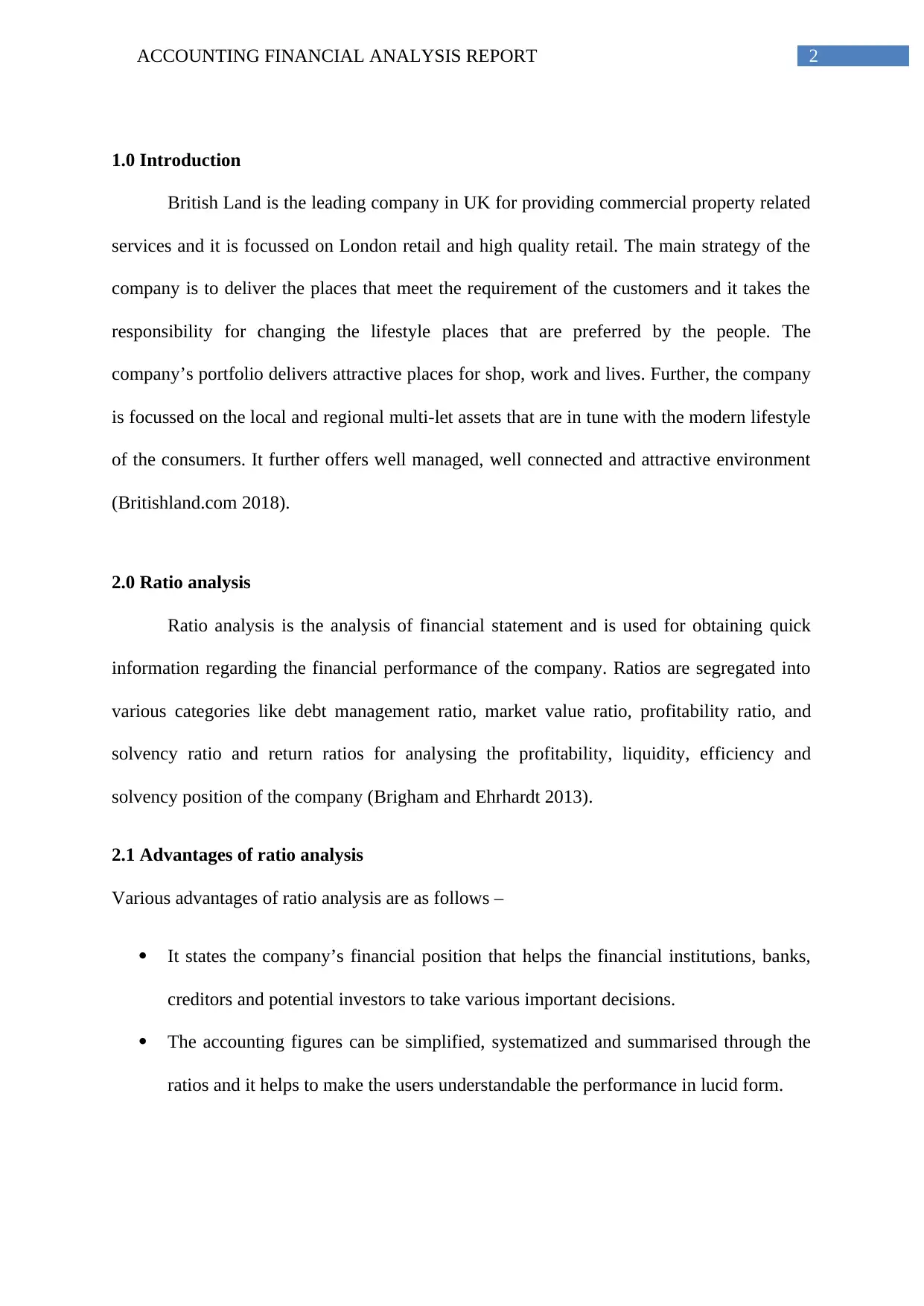
2ACCOUNTING FINANCIAL ANALYSIS REPORT
1.0 Introduction
British Land is the leading company in UK for providing commercial property related
services and it is focussed on London retail and high quality retail. The main strategy of the
company is to deliver the places that meet the requirement of the customers and it takes the
responsibility for changing the lifestyle places that are preferred by the people. The
company’s portfolio delivers attractive places for shop, work and lives. Further, the company
is focussed on the local and regional multi-let assets that are in tune with the modern lifestyle
of the consumers. It further offers well managed, well connected and attractive environment
(Britishland.com 2018).
2.0 Ratio analysis
Ratio analysis is the analysis of financial statement and is used for obtaining quick
information regarding the financial performance of the company. Ratios are segregated into
various categories like debt management ratio, market value ratio, profitability ratio, and
solvency ratio and return ratios for analysing the profitability, liquidity, efficiency and
solvency position of the company (Brigham and Ehrhardt 2013).
2.1 Advantages of ratio analysis
Various advantages of ratio analysis are as follows –
It states the company’s financial position that helps the financial institutions, banks,
creditors and potential investors to take various important decisions.
The accounting figures can be simplified, systematized and summarised through the
ratios and it helps to make the users understandable the performance in lucid form.
1.0 Introduction
British Land is the leading company in UK for providing commercial property related
services and it is focussed on London retail and high quality retail. The main strategy of the
company is to deliver the places that meet the requirement of the customers and it takes the
responsibility for changing the lifestyle places that are preferred by the people. The
company’s portfolio delivers attractive places for shop, work and lives. Further, the company
is focussed on the local and regional multi-let assets that are in tune with the modern lifestyle
of the consumers. It further offers well managed, well connected and attractive environment
(Britishland.com 2018).
2.0 Ratio analysis
Ratio analysis is the analysis of financial statement and is used for obtaining quick
information regarding the financial performance of the company. Ratios are segregated into
various categories like debt management ratio, market value ratio, profitability ratio, and
solvency ratio and return ratios for analysing the profitability, liquidity, efficiency and
solvency position of the company (Brigham and Ehrhardt 2013).
2.1 Advantages of ratio analysis
Various advantages of ratio analysis are as follows –
It states the company’s financial position that helps the financial institutions, banks,
creditors and potential investors to take various important decisions.
The accounting figures can be simplified, systematized and summarised through the
ratios and it helps to make the users understandable the performance in lucid form.
You're viewing a preview
Unlock full access by subscribing today!
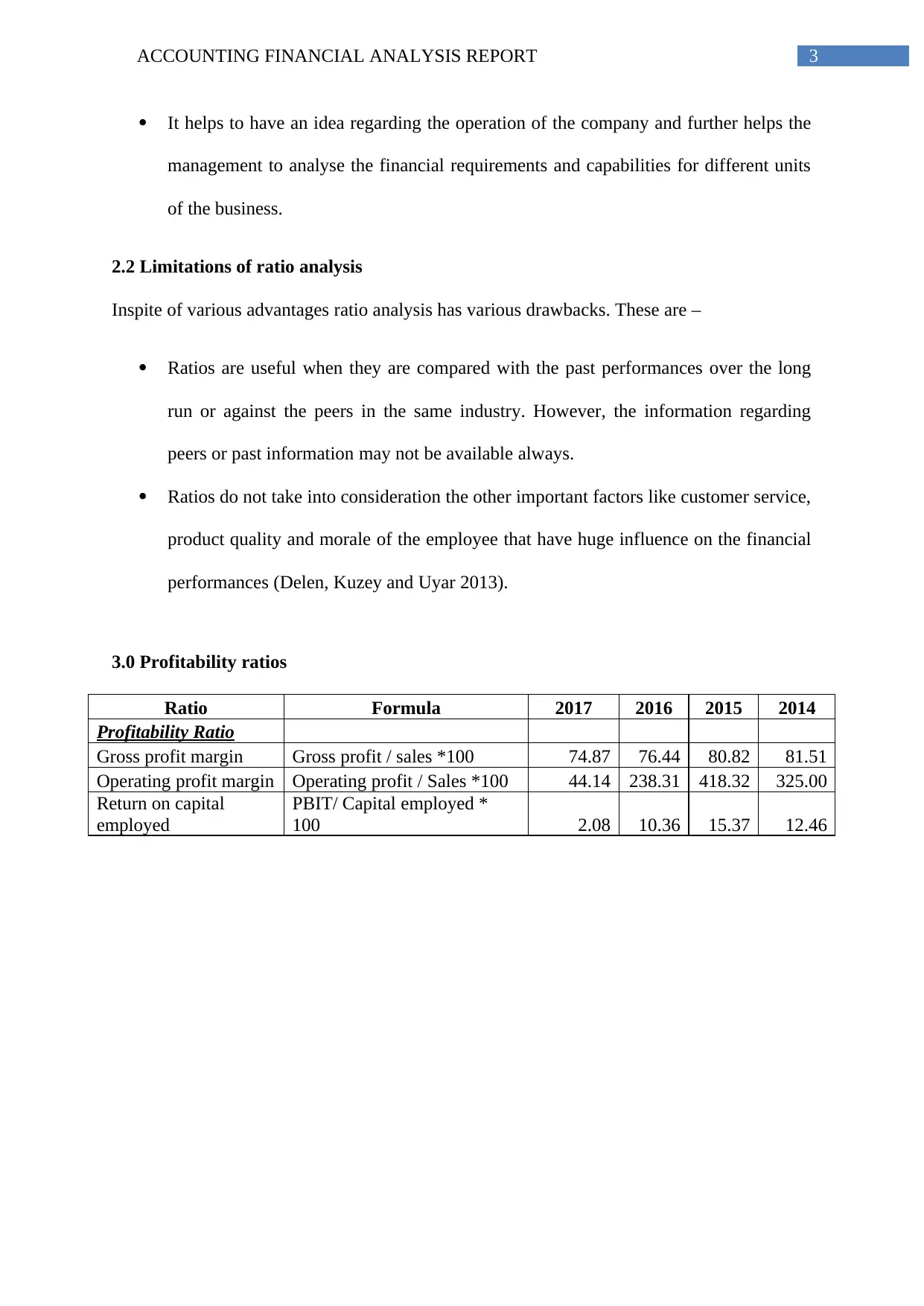
3ACCOUNTING FINANCIAL ANALYSIS REPORT
It helps to have an idea regarding the operation of the company and further helps the
management to analyse the financial requirements and capabilities for different units
of the business.
2.2 Limitations of ratio analysis
Inspite of various advantages ratio analysis has various drawbacks. These are –
Ratios are useful when they are compared with the past performances over the long
run or against the peers in the same industry. However, the information regarding
peers or past information may not be available always.
Ratios do not take into consideration the other important factors like customer service,
product quality and morale of the employee that have huge influence on the financial
performances (Delen, Kuzey and Uyar 2013).
3.0 Profitability ratios
Ratio Formula 2017 2016 2015 2014
Profitability Ratio
Gross profit margin Gross profit / sales *100 74.87 76.44 80.82 81.51
Operating profit margin Operating profit / Sales *100 44.14 238.31 418.32 325.00
Return on capital
employed
PBIT/ Capital employed *
100 2.08 10.36 15.37 12.46
It helps to have an idea regarding the operation of the company and further helps the
management to analyse the financial requirements and capabilities for different units
of the business.
2.2 Limitations of ratio analysis
Inspite of various advantages ratio analysis has various drawbacks. These are –
Ratios are useful when they are compared with the past performances over the long
run or against the peers in the same industry. However, the information regarding
peers or past information may not be available always.
Ratios do not take into consideration the other important factors like customer service,
product quality and morale of the employee that have huge influence on the financial
performances (Delen, Kuzey and Uyar 2013).
3.0 Profitability ratios
Ratio Formula 2017 2016 2015 2014
Profitability Ratio
Gross profit margin Gross profit / sales *100 74.87 76.44 80.82 81.51
Operating profit margin Operating profit / Sales *100 44.14 238.31 418.32 325.00
Return on capital
employed
PBIT/ Capital employed *
100 2.08 10.36 15.37 12.46
Paraphrase This Document
Need a fresh take? Get an instant paraphrase of this document with our AI Paraphraser
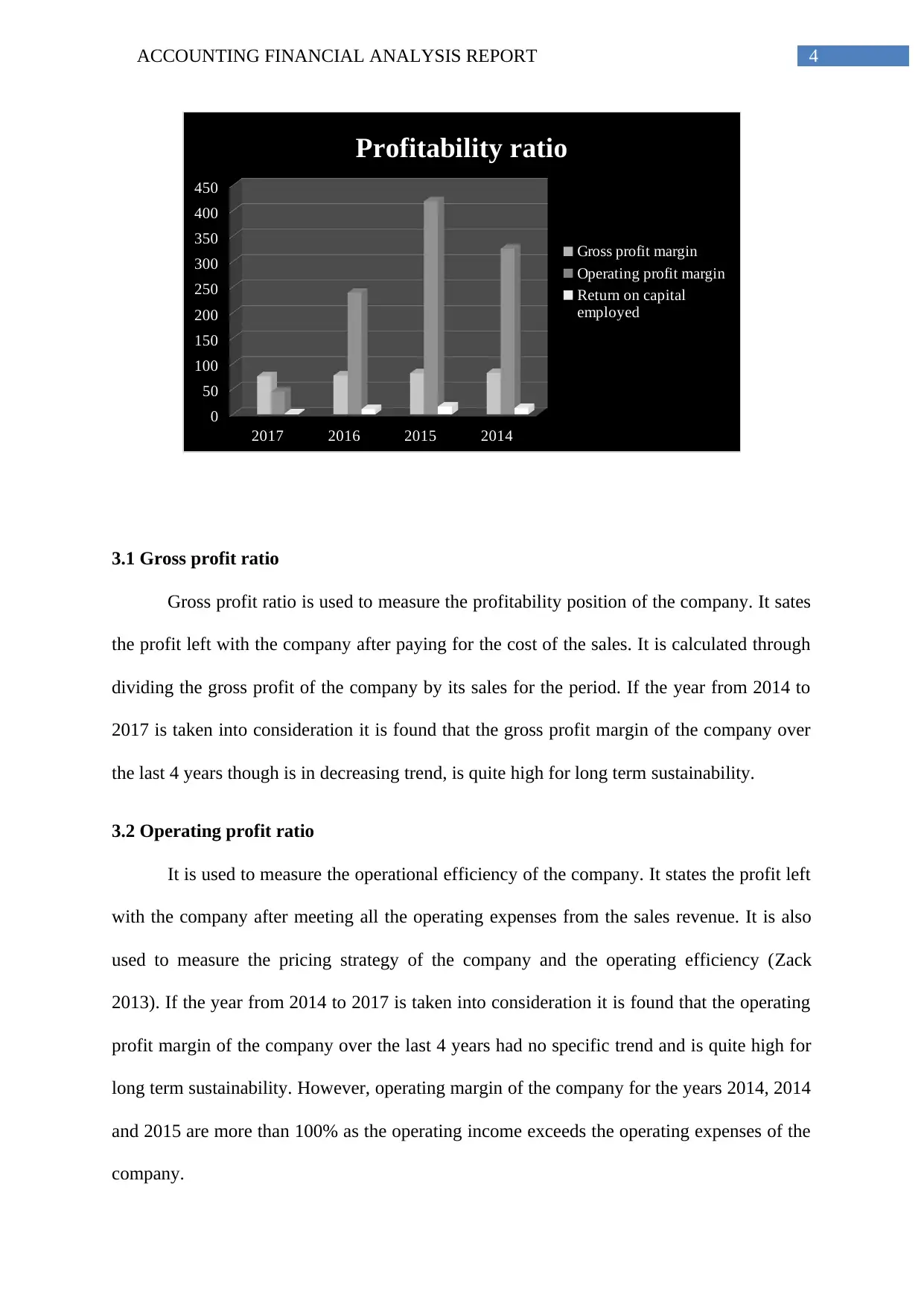
4ACCOUNTING FINANCIAL ANALYSIS REPORT
2017 2016 2015 2014
0
50
100
150
200
250
300
350
400
450
Profitability ratio
Gross profit margin
Operating profit margin
Return on capital
employed
3.1 Gross profit ratio
Gross profit ratio is used to measure the profitability position of the company. It sates
the profit left with the company after paying for the cost of the sales. It is calculated through
dividing the gross profit of the company by its sales for the period. If the year from 2014 to
2017 is taken into consideration it is found that the gross profit margin of the company over
the last 4 years though is in decreasing trend, is quite high for long term sustainability.
3.2 Operating profit ratio
It is used to measure the operational efficiency of the company. It states the profit left
with the company after meeting all the operating expenses from the sales revenue. It is also
used to measure the pricing strategy of the company and the operating efficiency (Zack
2013). If the year from 2014 to 2017 is taken into consideration it is found that the operating
profit margin of the company over the last 4 years had no specific trend and is quite high for
long term sustainability. However, operating margin of the company for the years 2014, 2014
and 2015 are more than 100% as the operating income exceeds the operating expenses of the
company.
2017 2016 2015 2014
0
50
100
150
200
250
300
350
400
450
Profitability ratio
Gross profit margin
Operating profit margin
Return on capital
employed
3.1 Gross profit ratio
Gross profit ratio is used to measure the profitability position of the company. It sates
the profit left with the company after paying for the cost of the sales. It is calculated through
dividing the gross profit of the company by its sales for the period. If the year from 2014 to
2017 is taken into consideration it is found that the gross profit margin of the company over
the last 4 years though is in decreasing trend, is quite high for long term sustainability.
3.2 Operating profit ratio
It is used to measure the operational efficiency of the company. It states the profit left
with the company after meeting all the operating expenses from the sales revenue. It is also
used to measure the pricing strategy of the company and the operating efficiency (Zack
2013). If the year from 2014 to 2017 is taken into consideration it is found that the operating
profit margin of the company over the last 4 years had no specific trend and is quite high for
long term sustainability. However, operating margin of the company for the years 2014, 2014
and 2015 are more than 100% as the operating income exceeds the operating expenses of the
company.
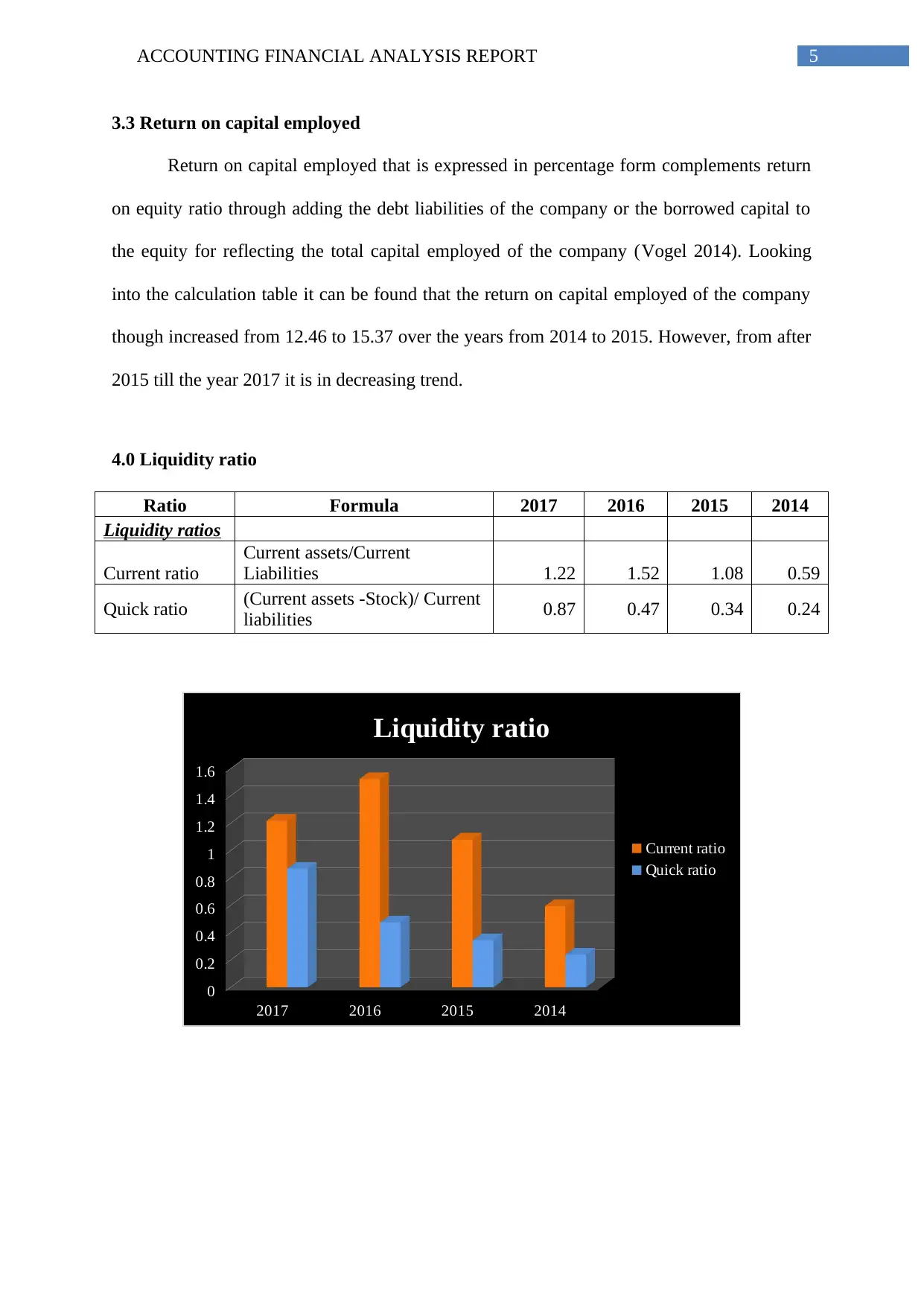
5ACCOUNTING FINANCIAL ANALYSIS REPORT
3.3 Return on capital employed
Return on capital employed that is expressed in percentage form complements return
on equity ratio through adding the debt liabilities of the company or the borrowed capital to
the equity for reflecting the total capital employed of the company (Vogel 2014). Looking
into the calculation table it can be found that the return on capital employed of the company
though increased from 12.46 to 15.37 over the years from 2014 to 2015. However, from after
2015 till the year 2017 it is in decreasing trend.
4.0 Liquidity ratio
Ratio Formula 2017 2016 2015 2014
Liquidity ratios
Current ratio
Current assets/Current
Liabilities 1.22 1.52 1.08 0.59
Quick ratio (Current assets -Stock)/ Current
liabilities 0.87 0.47 0.34 0.24
2017 2016 2015 2014
0
0.2
0.4
0.6
0.8
1
1.2
1.4
1.6
Liquidity ratio
Current ratio
Quick ratio
3.3 Return on capital employed
Return on capital employed that is expressed in percentage form complements return
on equity ratio through adding the debt liabilities of the company or the borrowed capital to
the equity for reflecting the total capital employed of the company (Vogel 2014). Looking
into the calculation table it can be found that the return on capital employed of the company
though increased from 12.46 to 15.37 over the years from 2014 to 2015. However, from after
2015 till the year 2017 it is in decreasing trend.
4.0 Liquidity ratio
Ratio Formula 2017 2016 2015 2014
Liquidity ratios
Current ratio
Current assets/Current
Liabilities 1.22 1.52 1.08 0.59
Quick ratio (Current assets -Stock)/ Current
liabilities 0.87 0.47 0.34 0.24
2017 2016 2015 2014
0
0.2
0.4
0.6
0.8
1
1.2
1.4
1.6
Liquidity ratio
Current ratio
Quick ratio
You're viewing a preview
Unlock full access by subscribing today!
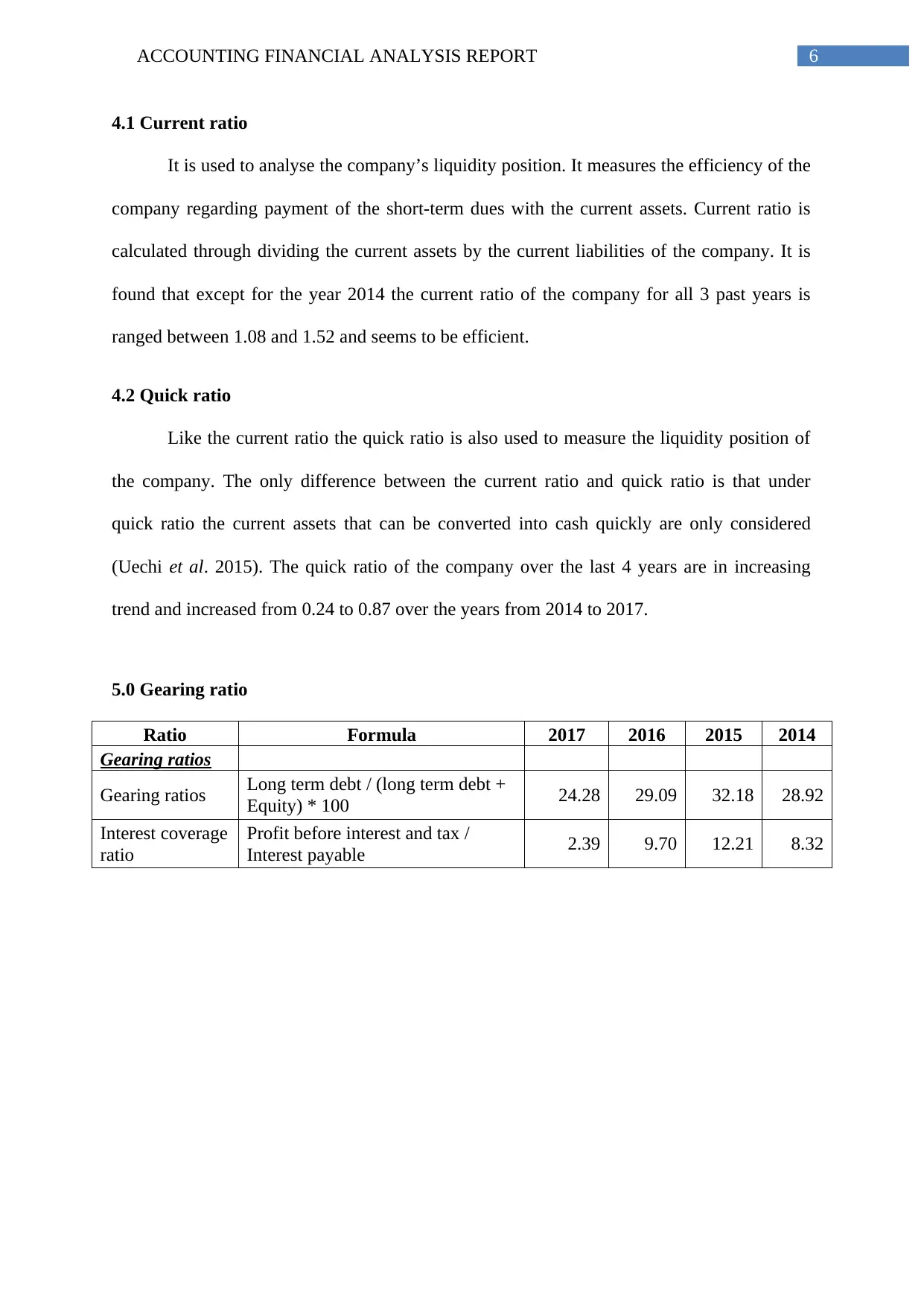
6ACCOUNTING FINANCIAL ANALYSIS REPORT
4.1 Current ratio
It is used to analyse the company’s liquidity position. It measures the efficiency of the
company regarding payment of the short-term dues with the current assets. Current ratio is
calculated through dividing the current assets by the current liabilities of the company. It is
found that except for the year 2014 the current ratio of the company for all 3 past years is
ranged between 1.08 and 1.52 and seems to be efficient.
4.2 Quick ratio
Like the current ratio the quick ratio is also used to measure the liquidity position of
the company. The only difference between the current ratio and quick ratio is that under
quick ratio the current assets that can be converted into cash quickly are only considered
(Uechi et al. 2015). The quick ratio of the company over the last 4 years are in increasing
trend and increased from 0.24 to 0.87 over the years from 2014 to 2017.
5.0 Gearing ratio
Ratio Formula 2017 2016 2015 2014
Gearing ratios
Gearing ratios Long term debt / (long term debt +
Equity) * 100 24.28 29.09 32.18 28.92
Interest coverage
ratio
Profit before interest and tax /
Interest payable 2.39 9.70 12.21 8.32
4.1 Current ratio
It is used to analyse the company’s liquidity position. It measures the efficiency of the
company regarding payment of the short-term dues with the current assets. Current ratio is
calculated through dividing the current assets by the current liabilities of the company. It is
found that except for the year 2014 the current ratio of the company for all 3 past years is
ranged between 1.08 and 1.52 and seems to be efficient.
4.2 Quick ratio
Like the current ratio the quick ratio is also used to measure the liquidity position of
the company. The only difference between the current ratio and quick ratio is that under
quick ratio the current assets that can be converted into cash quickly are only considered
(Uechi et al. 2015). The quick ratio of the company over the last 4 years are in increasing
trend and increased from 0.24 to 0.87 over the years from 2014 to 2017.
5.0 Gearing ratio
Ratio Formula 2017 2016 2015 2014
Gearing ratios
Gearing ratios Long term debt / (long term debt +
Equity) * 100 24.28 29.09 32.18 28.92
Interest coverage
ratio
Profit before interest and tax /
Interest payable 2.39 9.70 12.21 8.32
Paraphrase This Document
Need a fresh take? Get an instant paraphrase of this document with our AI Paraphraser
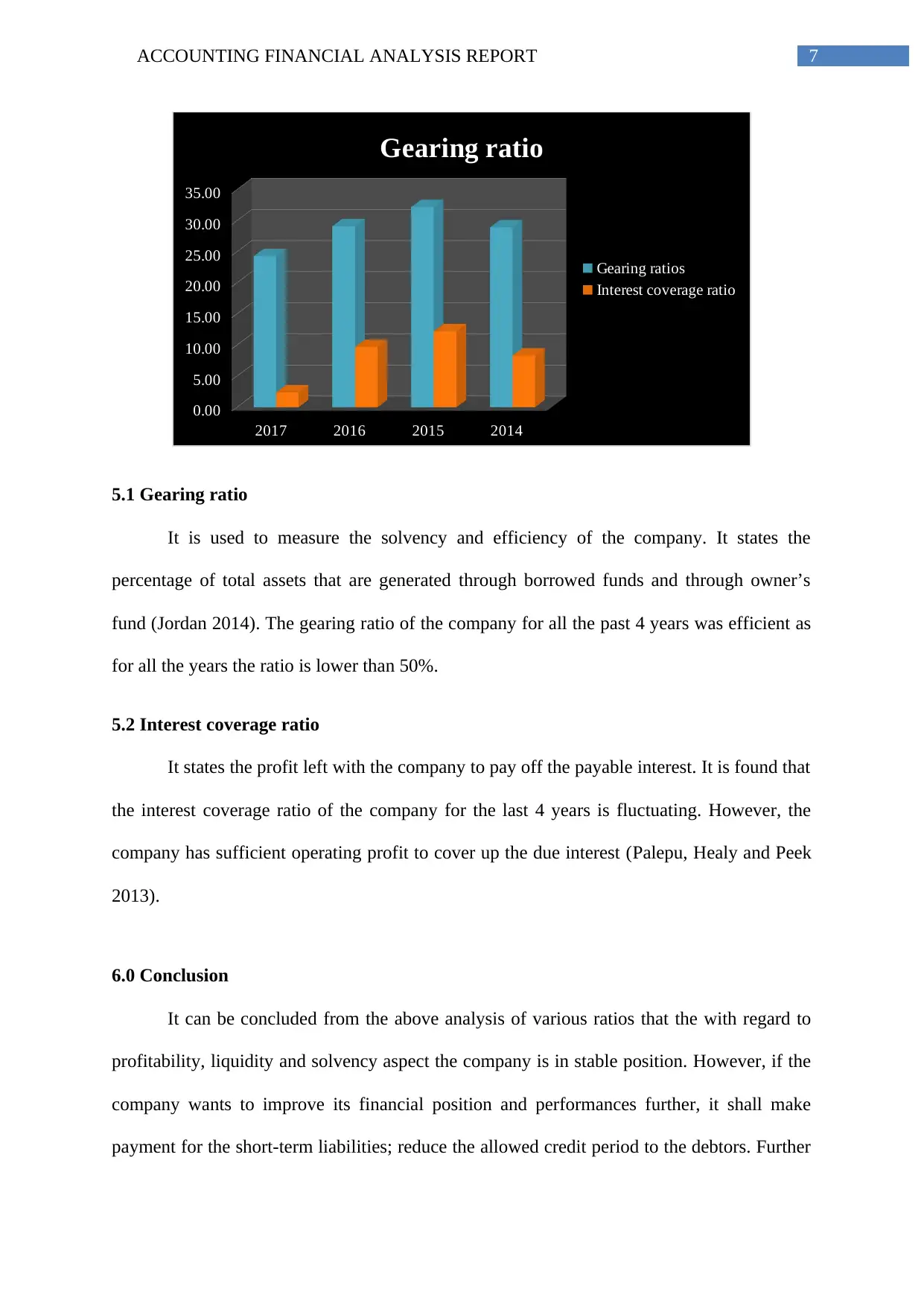
7ACCOUNTING FINANCIAL ANALYSIS REPORT
2017 2016 2015 2014
0.00
5.00
10.00
15.00
20.00
25.00
30.00
35.00
Gearing ratio
Gearing ratios
Interest coverage ratio
5.1 Gearing ratio
It is used to measure the solvency and efficiency of the company. It states the
percentage of total assets that are generated through borrowed funds and through owner’s
fund (Jordan 2014). The gearing ratio of the company for all the past 4 years was efficient as
for all the years the ratio is lower than 50%.
5.2 Interest coverage ratio
It states the profit left with the company to pay off the payable interest. It is found that
the interest coverage ratio of the company for the last 4 years is fluctuating. However, the
company has sufficient operating profit to cover up the due interest (Palepu, Healy and Peek
2013).
6.0 Conclusion
It can be concluded from the above analysis of various ratios that the with regard to
profitability, liquidity and solvency aspect the company is in stable position. However, if the
company wants to improve its financial position and performances further, it shall make
payment for the short-term liabilities; reduce the allowed credit period to the debtors. Further
2017 2016 2015 2014
0.00
5.00
10.00
15.00
20.00
25.00
30.00
35.00
Gearing ratio
Gearing ratios
Interest coverage ratio
5.1 Gearing ratio
It is used to measure the solvency and efficiency of the company. It states the
percentage of total assets that are generated through borrowed funds and through owner’s
fund (Jordan 2014). The gearing ratio of the company for all the past 4 years was efficient as
for all the years the ratio is lower than 50%.
5.2 Interest coverage ratio
It states the profit left with the company to pay off the payable interest. It is found that
the interest coverage ratio of the company for the last 4 years is fluctuating. However, the
company has sufficient operating profit to cover up the due interest (Palepu, Healy and Peek
2013).
6.0 Conclusion
It can be concluded from the above analysis of various ratios that the with regard to
profitability, liquidity and solvency aspect the company is in stable position. However, if the
company wants to improve its financial position and performances further, it shall make
payment for the short-term liabilities; reduce the allowed credit period to the debtors. Further
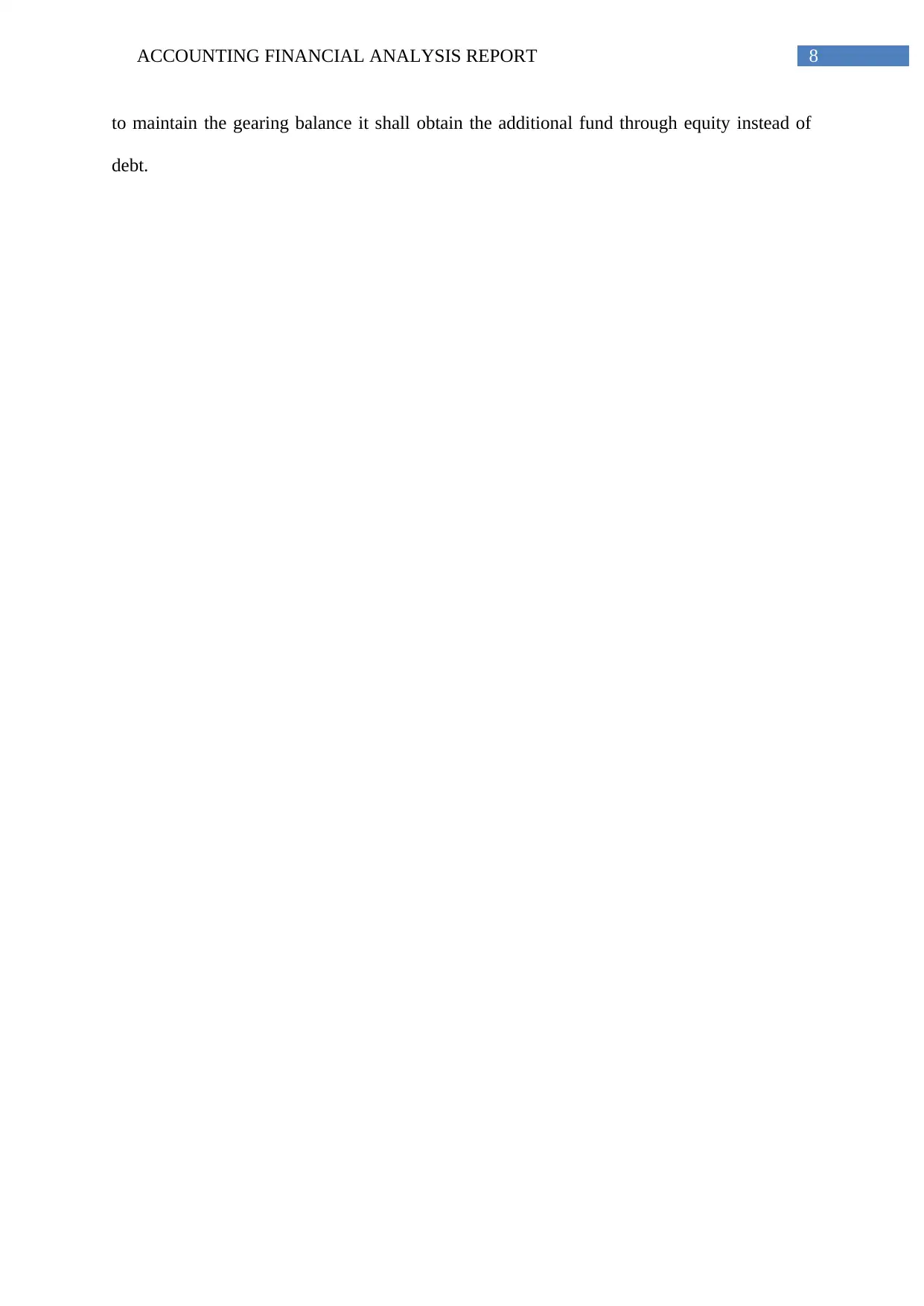
8ACCOUNTING FINANCIAL ANALYSIS REPORT
to maintain the gearing balance it shall obtain the additional fund through equity instead of
debt.
to maintain the gearing balance it shall obtain the additional fund through equity instead of
debt.
You're viewing a preview
Unlock full access by subscribing today!
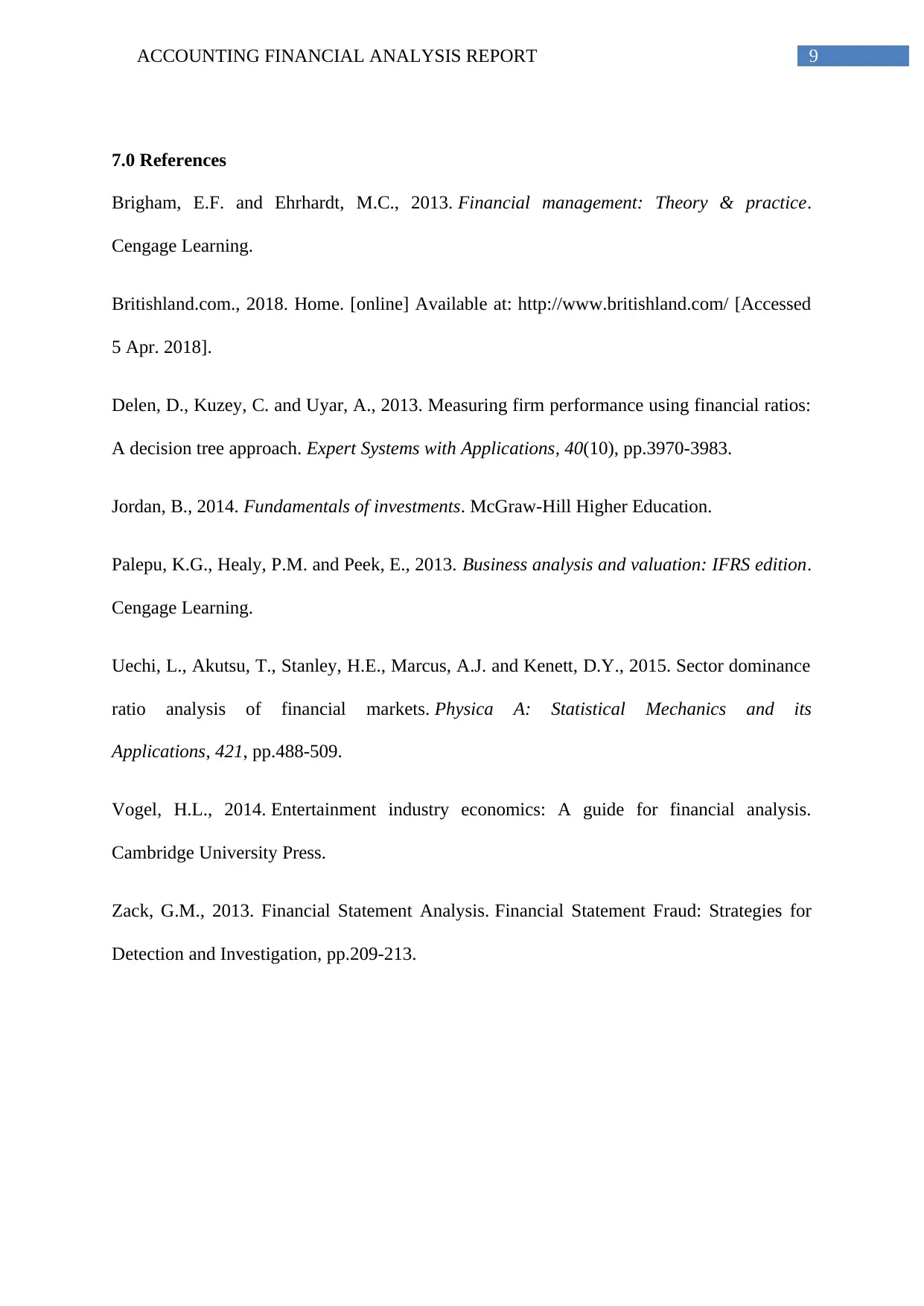
9ACCOUNTING FINANCIAL ANALYSIS REPORT
7.0 References
Brigham, E.F. and Ehrhardt, M.C., 2013. Financial management: Theory & practice.
Cengage Learning.
Britishland.com., 2018. Home. [online] Available at: http://www.britishland.com/ [Accessed
5 Apr. 2018].
Delen, D., Kuzey, C. and Uyar, A., 2013. Measuring firm performance using financial ratios:
A decision tree approach. Expert Systems with Applications, 40(10), pp.3970-3983.
Jordan, B., 2014. Fundamentals of investments. McGraw-Hill Higher Education.
Palepu, K.G., Healy, P.M. and Peek, E., 2013. Business analysis and valuation: IFRS edition.
Cengage Learning.
Uechi, L., Akutsu, T., Stanley, H.E., Marcus, A.J. and Kenett, D.Y., 2015. Sector dominance
ratio analysis of financial markets. Physica A: Statistical Mechanics and its
Applications, 421, pp.488-509.
Vogel, H.L., 2014. Entertainment industry economics: A guide for financial analysis.
Cambridge University Press.
Zack, G.M., 2013. Financial Statement Analysis. Financial Statement Fraud: Strategies for
Detection and Investigation, pp.209-213.
7.0 References
Brigham, E.F. and Ehrhardt, M.C., 2013. Financial management: Theory & practice.
Cengage Learning.
Britishland.com., 2018. Home. [online] Available at: http://www.britishland.com/ [Accessed
5 Apr. 2018].
Delen, D., Kuzey, C. and Uyar, A., 2013. Measuring firm performance using financial ratios:
A decision tree approach. Expert Systems with Applications, 40(10), pp.3970-3983.
Jordan, B., 2014. Fundamentals of investments. McGraw-Hill Higher Education.
Palepu, K.G., Healy, P.M. and Peek, E., 2013. Business analysis and valuation: IFRS edition.
Cengage Learning.
Uechi, L., Akutsu, T., Stanley, H.E., Marcus, A.J. and Kenett, D.Y., 2015. Sector dominance
ratio analysis of financial markets. Physica A: Statistical Mechanics and its
Applications, 421, pp.488-509.
Vogel, H.L., 2014. Entertainment industry economics: A guide for financial analysis.
Cambridge University Press.
Zack, G.M., 2013. Financial Statement Analysis. Financial Statement Fraud: Strategies for
Detection and Investigation, pp.209-213.
Paraphrase This Document
Need a fresh take? Get an instant paraphrase of this document with our AI Paraphraser
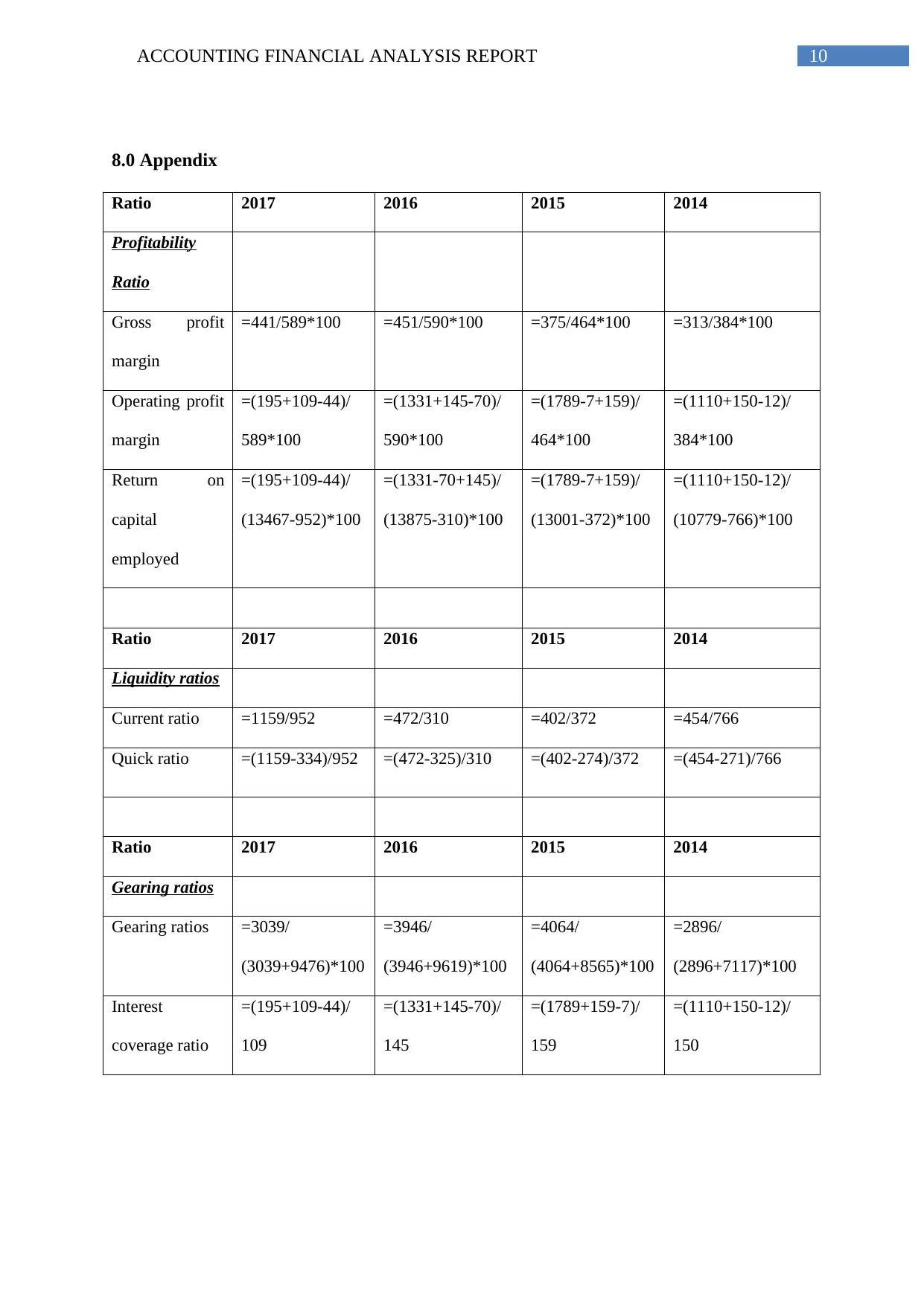
10ACCOUNTING FINANCIAL ANALYSIS REPORT
8.0 Appendix
Ratio 2017 2016 2015 2014
Profitability
Ratio
Gross profit
margin
=441/589*100 =451/590*100 =375/464*100 =313/384*100
Operating profit
margin
=(195+109-44)/
589*100
=(1331+145-70)/
590*100
=(1789-7+159)/
464*100
=(1110+150-12)/
384*100
Return on
capital
employed
=(195+109-44)/
(13467-952)*100
=(1331-70+145)/
(13875-310)*100
=(1789-7+159)/
(13001-372)*100
=(1110+150-12)/
(10779-766)*100
Ratio 2017 2016 2015 2014
Liquidity ratios
Current ratio =1159/952 =472/310 =402/372 =454/766
Quick ratio =(1159-334)/952 =(472-325)/310 =(402-274)/372 =(454-271)/766
Ratio 2017 2016 2015 2014
Gearing ratios
Gearing ratios =3039/
(3039+9476)*100
=3946/
(3946+9619)*100
=4064/
(4064+8565)*100
=2896/
(2896+7117)*100
Interest
coverage ratio
=(195+109-44)/
109
=(1331+145-70)/
145
=(1789+159-7)/
159
=(1110+150-12)/
150
8.0 Appendix
Ratio 2017 2016 2015 2014
Profitability
Ratio
Gross profit
margin
=441/589*100 =451/590*100 =375/464*100 =313/384*100
Operating profit
margin
=(195+109-44)/
589*100
=(1331+145-70)/
590*100
=(1789-7+159)/
464*100
=(1110+150-12)/
384*100
Return on
capital
employed
=(195+109-44)/
(13467-952)*100
=(1331-70+145)/
(13875-310)*100
=(1789-7+159)/
(13001-372)*100
=(1110+150-12)/
(10779-766)*100
Ratio 2017 2016 2015 2014
Liquidity ratios
Current ratio =1159/952 =472/310 =402/372 =454/766
Quick ratio =(1159-334)/952 =(472-325)/310 =(402-274)/372 =(454-271)/766
Ratio 2017 2016 2015 2014
Gearing ratios
Gearing ratios =3039/
(3039+9476)*100
=3946/
(3946+9619)*100
=4064/
(4064+8565)*100
=2896/
(2896+7117)*100
Interest
coverage ratio
=(195+109-44)/
109
=(1331+145-70)/
145
=(1789+159-7)/
159
=(1110+150-12)/
150
1 out of 11
Related Documents
Your All-in-One AI-Powered Toolkit for Academic Success.
+13062052269
info@desklib.com
Available 24*7 on WhatsApp / Email
![[object Object]](/_next/static/media/star-bottom.7253800d.svg)
Unlock your academic potential
© 2024 | Zucol Services PVT LTD | All rights reserved.





